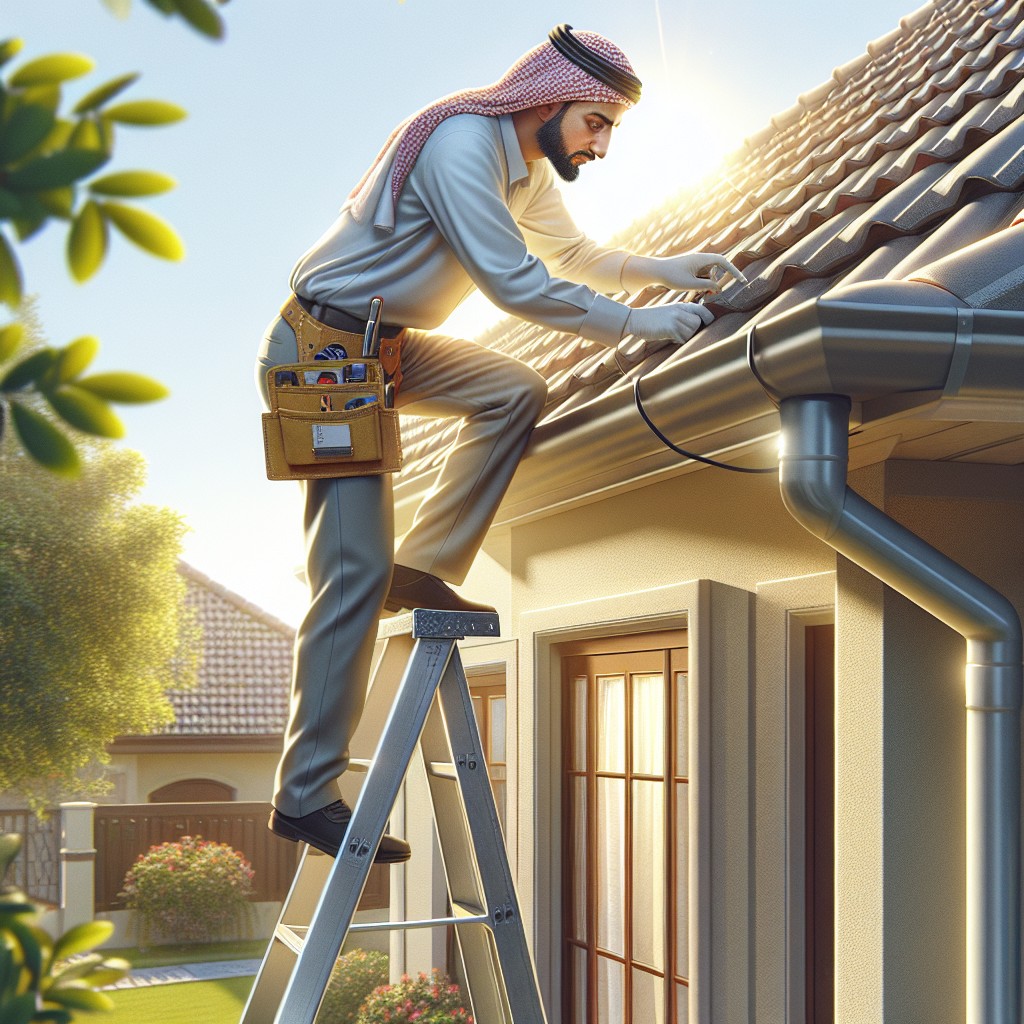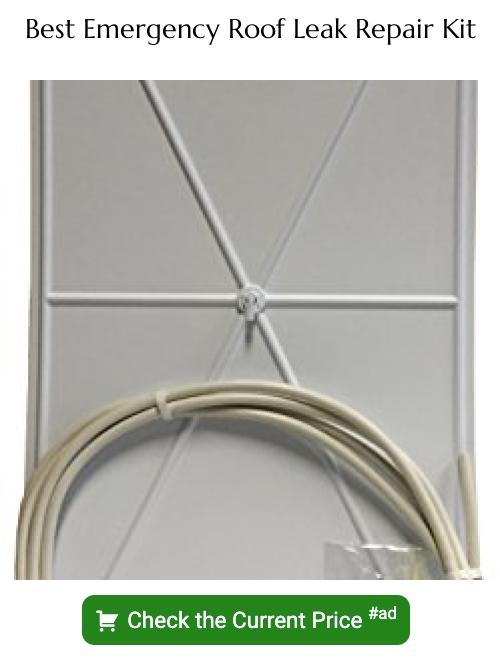Last updated on
Addressing an emergency roof leak swiftly is crucial because water damage can intensify quickly, leading to costly repairs and structural issues.
Key takeaways:
- Immediate Steps: Contain water, relieve pressure, move valuables, document damage, examine safety.
- Identify Source: Check attic, inspect roof, trace water with hose.
- Temporary Solutions: Use plywood and roofing tar or tarp for patching.
- Tarp Application: Size selection, secure placement, use boards or weighted edges.
- Professional Repairs: Comprehensive assessment, suitable methods, quality materials, safety ensured, warranty provided.
Immediate Steps to Take During an Emergency Roof Leak

Upon discovering a roof leak, immediate action can help prevent extensive damage:
1. Contain Water Spread: Place buckets or containers under drips to catch water. Overlapping tarps or plastic sheets can help divert water flow to a specific area, reducing the spread.
2. Relieve Water Pressure: If you spot a bulging water pocket on your ceiling, puncture it carefully with a screwdriver or similar tool to release the water and alleviate potential ceiling damage.
3. Move Valuables: Quickly relocate furniture, electronics, and other items away from the leak to prevent water damage. Cover large items with waterproof coverings if moving them is not feasible.
4. Document Damage: Take photos or videos of the leak and any damage it has caused. This documentation is crucial for insurance claims and for the roofing professional to assess the urgency of the repair needed.
5. Examine Safety Risk: Assess the area around the leak for safety risks, such as the potential for slipping hazards and electrical risks from water contact.
These initial responses can minimize the impact of a roof leak, buying time until professional repairs can be made.
Identifying the Source of the Leak

To locate a roof leak, start by examining the attic. Look for signs of water intrusion, like wet rafters or water stains.
Climb onto the roof, if safely possible, and check for damaged, loose, or missing shingles. Inspect flashing around vents, chimneys, and skylights, as these are common leak points.
Consider water tracing with a hose on the rooftop to pinpoint the leak’s exact location. Remember that water can travel from the initial entry point, so the area of interior damage might not be directly below the leak.
Temporary Solutions for a Roof Leak
When faced with a sudden roof leak, a quick and effective response is crucial to prevent further damage. Begin by placing a bucket or other container beneath the drip to catch water. Once the immediate threat to your interior is contained, locate the leak’s entry point from inside your attic. If safe to do so, use a piece of plywood and roofing tar to create a temporary patch. Apply the tar to the plywood, then place it over the leak.
Alternatively, if it’s possible to reach the affected area from the outside, cover the site with a waterproof tarp. Stretch the tarp flat over the leak, extending it over ridges to ensure runoff. Secure it with nails or tuck the edges under roofing shingles to prevent wind displacement. Remember, these are temporary fixes that buy time; consult with a roofing professional to explore permanent solutions.
Using a Tarp to Mitigate Further Damage
A heavy-duty, waterproof tarp is an excellent tool to quickly protect the compromised area of a roof. Here’s how to apply a tarp effectively:
1. Size Selection: Ensure the tarp is sufficiently large to cover the leak area and extend beyond it by at least 3 feet on all sides.
2. Secure Placement: Center the tarp over the leak, and smooth it flat against the roof. The tarp should lie directly on the shingles to prevent water from pooling underneath.
3. Board Technique: To hold the tarp in place, use 2×4 wooden boards. Wrap the tarp’s ends around the boards and nail the boards to the roof or the roof’s edges. This not only secures the tarp but also creates an angled run-off for rainwater.
4. Weighted Edges: If nailing is not an option, use bricks or heavy objects to anchor the tarp’s edges, avoiding potential perforation.
Remember, this is a temporary fix to minimize damage until a professional can perform permanent repairs. Regularly check the tarp for any signs of wear or further damage during its temporary use.
Professional Roof Leak Repairs
When faced with a complex roof leak, enlisting the help of professionals is crucial for a reliable and long-lasting repair. Roofing specialists bring expertise that goes beyond the scope of temporary fixes, applying their knowledge of various roofing materials and repair techniques to address the underlying cause of the leak.
- Comprehensive Assessment: An expert begins by thoroughly evaluating the extent of water damage to both external and internal structures.
- Suitable Repair Methods: Depending on the roof type and damage severity, they might replace shingles, seal gaps, or reapply flashing.
- Quality Materials: Professionals ensure the use of industry-standard materials that are compatible with your roof, offering durability against future leaks.
- Safety Ensured: Roofers adhere to strict safety codes to prevent accidents during repair work, a notable advantage over DIY methods.
- Warranty and Reliability: A professional repair typically comes with a warranty, giving homeowners peace of mind knowing that the repair is guaranteed.
Access to professional roof repair services ultimately mitigates the risk of recurrent leaks, structural damage, and costly future repairs.
Emergency Patching Vs. Permanent Solutions
Emergency patching of a roof leak is a short-term fix designed to prevent water from entering the home until professional repairs can be performed. This method is generally quick and cost-effective, involving materials such as roofing tape, sealants, or a tarpaulin to cover the affected area securely.
In contrast, permanent solutions address the root cause of the leak and may include replacing shingles, resealing flashings, or fixing the underlayment. These repairs are more comprehensive and are meant to restore the integrity of the roof for the long term. Permanent repair work should always be carried out by skilled professionals to ensure the roof is properly fixed and to avoid future leaks.
It’s important to understand that emergency patching is only a temporary measure. Prolonged reliance on such fixes without proper resolution can lead to more serious damage, increased repair costs, and potential safety hazards. Always plan for a permanent repair as soon as weather and circumstances permit.
Contacting a Professional Roofer
In the event of a roof leak, promptly reaching out to a professional roofer is critical for preventing long-term damage. Roofing experts have the requisite skills and tools to safely assess and fix the issue.
Here are key points to consider when seeking a professional’s help:
- Availability: Search for roofers who offer emergency services to address your issue as soon as possible.
- Credentials: Verify their licensing and insurance to ensure they are qualified to perform the work in your region.
- Experience: Look for professionals with a solid track record of handling emergency repairs.
- Assessment: Expect a thorough inspection to determine the full extent of the damage.
- Estimates: Professionals should provide a clear, written estimate detailing the costs involved.
- Warranty: Inquire about any guarantees on the repair work to protect your investment.
Secure a professional with a swift response time and a reputation for quality workmanship to promptly address your roofing emergency.
Types of Roof Damage Handled By Professionals
Professionals address a diverse range of roof problems to protect your home from further harm. This includes:
- Missing or broken shingles: Extreme weather can dislodge shingles, leaving the roof vulnerable to water ingress.
- Cracked flashing: This metal installed in the joints of the roof can crack and cause leaks if not sealed properly.
- Damaged vent booting: Roof vents have seals that can deteriorate over time, allowing water to seep in around them.
- Punctures and holes: Years of weather exposure and external factors can lead to punctures that need immediate sealing.
- Clogged gutters: Leaves and debris prevent proper water drainage, causing water to pool and potentially enter the structure.
- Skylight leaks: Incorrect installation or degraded seals can turn skylights into a common leak source.
By addressing these issues promptly, professionals help maintain the structural integrity of the roof and prevent interior water damage.
Services Offered
When facing a roof leak emergency, professional roofers provide a range of services to address both immediate and long-term needs:
– 24/7 Emergency Response: Readily available to assess and address urgent leaks at any time. – Leak Diagnosis: Accurate identification of the leak’s origin using tools and expertise to prevent further interior and structural damage. – Temporary Patches: Application of emergency patches to prevent water ingress until permanent repairs can be made. – Water Damage Assessment: Evaluation of any structural damage caused by the leak, such as rotted wood or compromised insulation. – Permanent Roof Repair: Comprehensive solutions that may include replacement of shingles, sealing of joints, and fixing flashing to ensure a long-lasting repair. – Preventative Maintenance: Recommendations and services that help avoid future leaks, like gutter cleaning and shingle replacement. – Guaranteed Work: Assurance of quality through warranties on both materials and labor. – Insurance Claim Assistance: Guidance through the process of filing a claim with insurance providers to cover repair costs.These services aim to restore the integrity of your roof with minimal disruption and maximum efficacy.
Contact Information for Immediate Assistance
In the event of a roof leak, immediate assistance is imperative to prevent further damage. It is essential to have on hand the contact information for reputable roofing contractors who offer emergency services. Some may provide 24/7 support to address urgent repairs.
- Maintain a list of local roofing contractors with emergency repair services.
- Verify the availability of 24-hour service options.
- Check for contractors who can provide immediate on-site assessments.
- Ensure the contact list includes businesses with credible reviews and proper licensing.
- Consider using smartphone apps or websites that specialize in connecting homeowners with professionals for emergency repairs.
Acting swiftly can save your home from significant water damage, so ensure the contact information is easily accessible at all times.
FAQ
Is a leaking roof an emergency?
Yes, a leaking roof can be considered an emergency if it severely damages your home to the point of making it uninhabitable or if the structure is exposed to the elements, necessitating immediate contact with a roofing expert.
Are roof leaks emergencies?
Regardless of their size, roof leaks are considered emergencies.
How do you emergency patch a roof?
To emergency patch a roof, place a household tarp over the damaged section and secure it with heavy boards around its edges until professional roofers can execute a permanent repair.
What are the immediate steps to take after discovering a roof leak?
Upon discovering a roof leak, immediately halt any electrical appliances in the affected area, contain the water, note the leak characteristics for potential repairs, and contact a professional roofer for a thorough inspection and possible repair.
How can one determine the severity of a roof leak?
The severity of a roof leak can be determined by factors such as the size of the water stain, rate of dripping, damage on the interior such as peeling paint or discolored walls, and presence of mold or mildew.
What common household items can be used for a temporary roof leak fix?
Common household items for a temporary roof leak fix include a wire brush, roofing cement, putty knife, and a piece of sheet metal.





